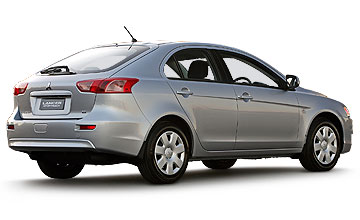BY BYRON MATHIOUDAKIS | 27th Oct 2008

Cast your mind way back to when Kurt Cobain was alive, Strictly Ballroom was slaying them in the aisles and John Hewson was thought to be our next Liberal prime minister... and you get some idea when the Lancer last had a liftback body.
That was the rather awkwardly styled CA/CB-series Lancer that was born during the genesis of the last (major) recession and survived right through to the arrival of the long-lived CE series Lancer in 1996.
Okay, the related CE Mirage was kind of like having a three-door version, and Malaysia’s Proton has made plenty of hay with the CC Lancer-based Wira/Persona of the latter 1990s, but poor old Mitsubishi had to sit and bide its time as Australians voted for their hatch-over-sedan preferences with their wallets.
So you can imagine all the pent-up enthusiasm reserved for the return of the prodigal hatch in the latest, CJ Lancer range from the bigwigs at Mitsubishi.
Finally, they’re not having to fight in the cut-throat small-car segment with one arm tied behind their backs finally, the Japanese importer now has access to around the 60 per cent of the segment that hitherto was denied to it.
So is the Sportback worth it?
Is it how!
Good on ya, Mitsubishi, for fitting in a long and wide tail-gate with a little handle at both ends to automatically fold the rear backrest flush down onto its cushion. Why hasn’t anybody else thought of that for this class? An identical Karakuri set-up has been in the Mazda6 since 2002.
But these are merely icings on a tasty small-car cake.
The Sportback has real styling appeal, building on the Lancer sedan’s shark-like wedge design to create a car that speaks to all sexes.
There’s certainly enough space inside, with ample room for taller adults at the front, while the tiny reduction in rear headroom is miniscule.
Finding a comfy driving position is easy too, even though Mitsubishi doesn’t fit a reach mechanism to the tilt-adjustable steering column.
We noticed a small amount of rack rattle on certain (uneven) road surfaces, but it’s barely there we didn’t much like the shiny black plastic finish on the fascia – it looks a little bit cheap.
Noticeable road noise mars cabin refinement in some scenarios too, but not all the time and rear vision is abysmal due to those thick C-pillars.
Yet none of these are deal-breakers for us, as most small cars under $30,000 suffer from some road-noise intrusion (hello Mazda) and even though we found the steering a tad light on feel, we thoroughly enjoyed driving the VRX version of the Sportback.
Find a corner and the Lancer will grip firmly to the tarmac as it takes you around in an easy, controllable arc. Bumps and stuff don’t upset its chosen line, while the driver can enjoy adjusting the vehicle to his or her desire mid-way through a turn with reassuring control.
Perhaps those wider-aspect tyres and larger disc brakes help in this VRX, but whatever the case, drivers are likely to find the Lancer agile and rewarding.
Unfortunately, MMAL didn’t have the rather sweet 2.0-litre four-cylinder petrol engine models on hand, so we had to assess the Lancer in its semi-sporty guise it’s like summing up a Ford Focus purely by sampling a Zetec model.
Actually, the 2.4-litre in the VRX is one of those engines that feels adequately sprightly on take-off but then quietly builds up big speeds without the driver realising it.
Mid-range acceleration is very strong in the CVT continuously variable transmission-fitted Sportback we were driving. The two make for a nice, helpful pair, getting you going when instant overtaking is required, with minimum intrusion or ‘clutch slippage’ that used to define old-school CVTs.
Ride quality is another Lancer plus-point, proving that Mitsubishi’s decision to go with the multi-link rear-end way back whenever was the correct one.
We came away impressed with the new Lancer Sportback. It feels and drives like a well-engineered, well-researched small car that draws upon the series’ rally-bred past to provide present and future owners with a certain amount of pride.
With this in mind, we beg the question again: how did Mitsubishi go through almost one-and-a-half decades without a five-door hatchback small car? The Sportback is good enough to make you think Mitsubishi’s been building them all along.